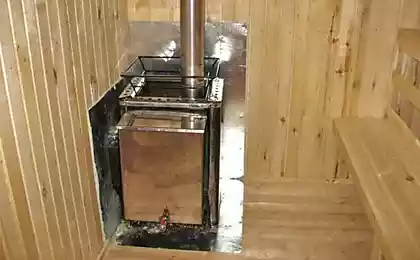1663
Geliokompleks Sun
No, this is not the base of the aliens shooting area and sci-fi movies. It - Great Solar Furnace (BSP) with a capacity of 700 kilowatts, located in Uzbekistan. Total in the world two of the furnace, the second is in France.
Big solar furnace is a complex optical-mechanical complex with automatic control system, consisting of geliostatnogo field and a parabolic concentrator, which form the focal zone in the steady stream of high energy density. The area of the reflecting surface geliostatnogo field - 3020 m², the hub - 1840 m². The temperature in the concentrator focus rays exceeds 3,000 degrees Celsius. This is the largest solar furnace in the world.

Geliokompleks located 45 km from Tashkent, in Parkent area, in the foothills of the Tien Shan mountains at an altitude of 1100 meters above sea level. It was built between 1981 and 1987. Place for building very carefully chosen: first the whole complex is located on a single rock mass, which is very important because it is located in a seismically hazardous area, and secondly, the number of sunny days per year is not less than 270.

Let's start with the examination of a small solar oven. It is a mirror parabaloid diameter of about 2 meters, focusing the sun's rays to a point with a diameter of 2 centimeters.

The maximum temperature that can be obtained in the furnace - 2000 degrees Celsius. An interesting visual effect can be observed with objects placed closer focal distance. For example, the image of a man standing next to the mirror increases, and all that is reflected in the further upside.
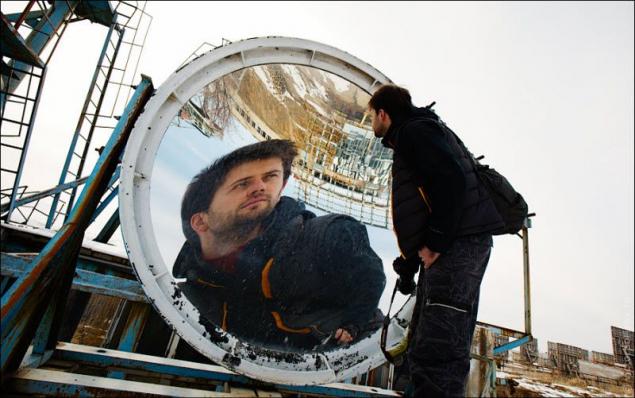
"Will the party, the desire of the people there will be built a complex of the Sun" in May 1981. To realize the ambitious project "Institute of the Sun" has been made possible thanks to the efforts and enthusiasm of academician Said Azimovich Asimov. Triangulation station and the memorial plaque on the highest point of the complex - 1100 meters above sea level.
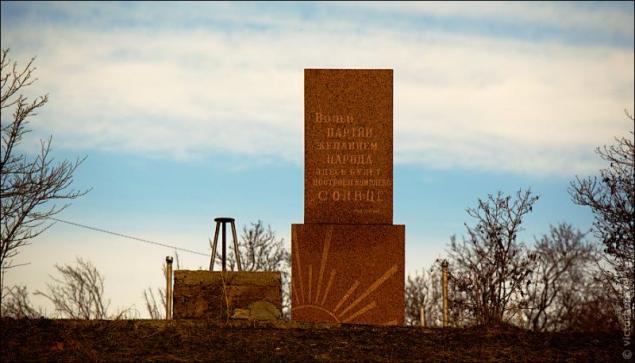
Science geliokompleks includes 4 units: the main building, geliostatnoe field concentrator technology tower.
Geliostatnoe field consists of 62 heliostats arranged in a checkerboard pattern (to reduce shading) on a gentle slope of the mountain opposite the hub.

Each heliostat size 7, 5x6, 5 meters is made up of 195 flat mirror elements called "facets».
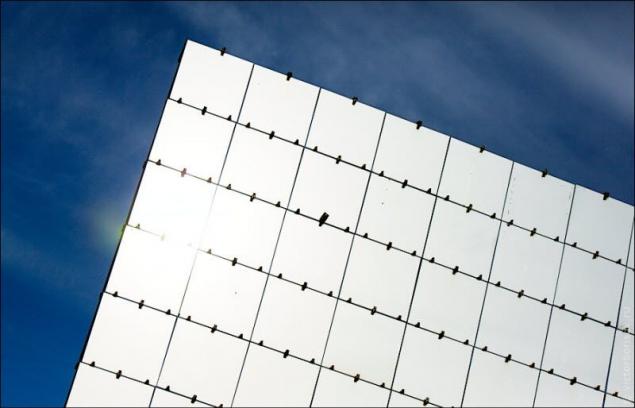
Reflective area geliostatnogo field is 3022 square meters.
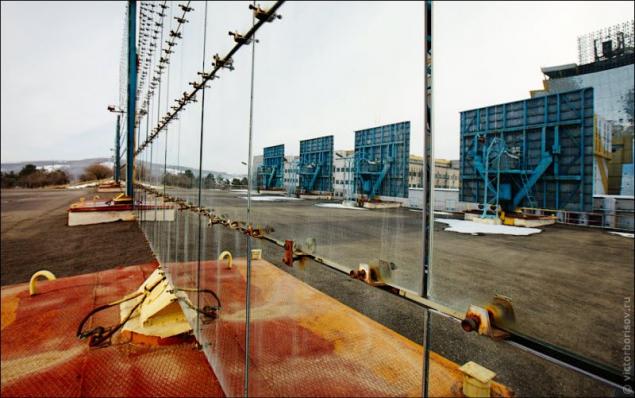
From the archive. Longitudinal section of the concentrator and geliostatnogo field.

The sensors automatically adjust the position of each heliostat in accordance with the movement of the sun. Each heliostat can be rotated both vertically and horizontally.

The size of the individual mirrors - 50x50 centimeters.

The reflective layer of the facet is formed by vacuum deposition of aluminum on the rear side and secured with acrylic paint.

A total of 12090 geliostatnom field is used mirrors.

Mirror Control is fully automated and uses ready-made program for each day, taking into account the position of the sun in the sky.

And here is the main object - the parabolic solar concentrator. It is the world's largest gelikontsentrator, an area of 1840 square meters. To assess the scale look at the people at the bottom left of the frame.
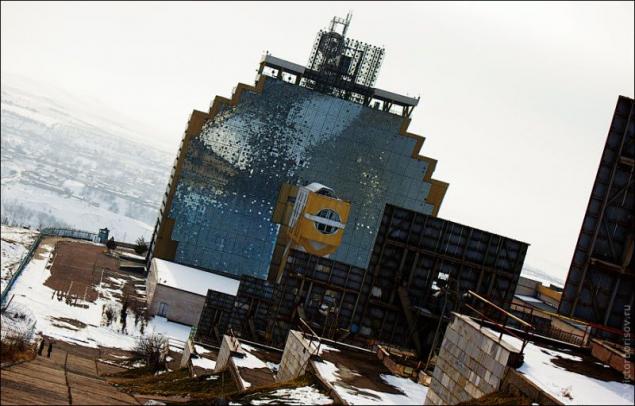
From the archive. Design Hub and geliostatnogo field.

The concentrator uses 10,700 mirrors, a total area of 1840 square meters. Mirrors 214 are assembled in blocks of size 4, 5x2, 25 meters, 50 in each mirrors.

The hub is fixedly positioned and oriented in a north-south direction.
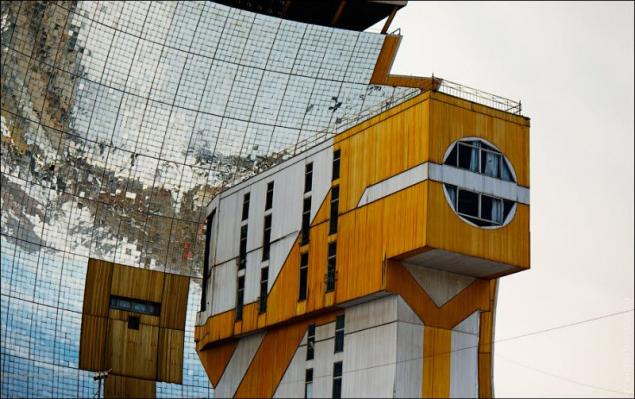
The flow of solar energy, aimed heliostats is reflected from the mirror surface of the parabolic concentrator and is focused at one point on a technological tower with a diameter of 40 centimeters.

In the center of the parabolic surface of the hub, at the height of 6 floors, located pyrometric laboratory, where control the operation of the furnace.

Panoramic view of the tower and technological hub.

The highest point of the concentrator account for the mark of 1100 meters above sea level, which coincides with the point of installation of a plaque on top geliostatnogo field. The size of the "mirror" hub - 47h54 meters. And every single mirror has a size of 45x45 centimeters.

Weight of metal structures Hub - 200 thous. Tons. On the top (12th floor) goes Utility lift. And this is the hub looks from the inside.
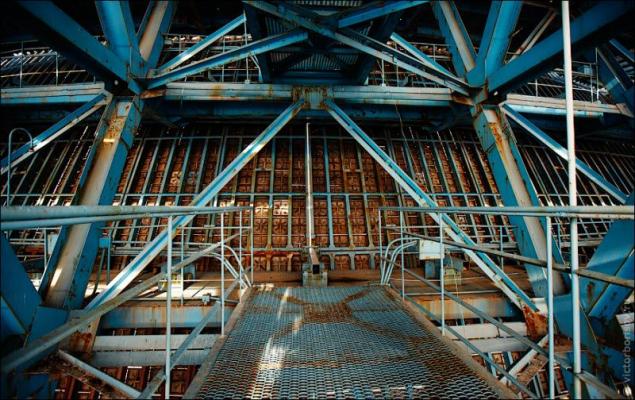
South side of the hub. To protect against sunlight and temperature deformation metallikonstruktsy Hub closed special sun screens. In the foreground is a simple experimental solar furnace assembled from steel sheets.

Pyrometric laboratory on the 6th floor of the concentrator. Its windows overlook the process tower. Hence, control the operation of the furnace.

At the top mark the hub is an observation deck. Below the village is sun, condominium for employees of the institute.

More above the red sight buttons to align all 62 heliostats.

Hence it offers panoramic views of the geliostatnoe field.

Matrix target marks.

Focal Length hub - 18 meters, it was at this distance is a technological tower with oven. In the idle state and the closed oven door forcibly cooled.

Staircase-lift block on the south side of the hub.

The advantage of the solar furnace consists of achieving an instantaneous high temperature, allowing to obtain pure material without contaminants (including through the clean mountain air). Therefore it metals and alloys are characterized by an extremely high purity and lack of contaminants. And one more important argument - for solar energy did not have to pay.

Well, of course we can not ignore the second big solar furnace in the world.
Large Solar Furnace in Font-Romeu-Odeillo (France)
Sun Laboratory was the world's first solar furnace dimensioned. Its construction was carried out in 1962-1968, respectively. The entire complex earned in 1970. The furnace consists of a parabolic concentrator, with dimensions of 63 meters and 54h48 heliostats. The total area of the reflecting surface of the concentrator only 10 square meters less than that of the BSP in Parkent, but due to the fact that the entire complex is situated above (at an altitude of 1600 meters above sea level) and applied a high-quality mirror - the maximum capacity of the French solar furnace above and is 1 MW.

BSP can be used to clean metal zirconium without any impurities. The melting point of zirconia - 2700 degrees Celsius! Furnace in this case may be about 2, 5 tonnes of zirconium per day.

You agree that geliokompleksy very similar to each other.

Summarizing
Currently, the Physico-Technical Institute (PTI) NGO "Physics-Sun" are engaged in scientific and technological development in the field of high energy physics, physics of semiconductors, solar energy conversion, solid-state theory.
Once it was carried out the test plating spacecraft and military vehicles, and now at the Institute set up a production line of ceramic products based on the materials synthesized in the BSP. In particular, this body fuses and high-voltage porcelain. It also designed and built a small solar furnace, capacity of 1500 Watts, who are already working in Egypt and India. More BSP can be used as an astrophysical tool for studies of the sky at night.
Unique technical base complex "Physics-Sun" allows versatile observation of the sun and do not only theoretical but also experimental studies.
Source: victorprofessor.livejournal.com
Big solar furnace is a complex optical-mechanical complex with automatic control system, consisting of geliostatnogo field and a parabolic concentrator, which form the focal zone in the steady stream of high energy density. The area of the reflecting surface geliostatnogo field - 3020 m², the hub - 1840 m². The temperature in the concentrator focus rays exceeds 3,000 degrees Celsius. This is the largest solar furnace in the world.

Geliokompleks located 45 km from Tashkent, in Parkent area, in the foothills of the Tien Shan mountains at an altitude of 1100 meters above sea level. It was built between 1981 and 1987. Place for building very carefully chosen: first the whole complex is located on a single rock mass, which is very important because it is located in a seismically hazardous area, and secondly, the number of sunny days per year is not less than 270.

Let's start with the examination of a small solar oven. It is a mirror parabaloid diameter of about 2 meters, focusing the sun's rays to a point with a diameter of 2 centimeters.

The maximum temperature that can be obtained in the furnace - 2000 degrees Celsius. An interesting visual effect can be observed with objects placed closer focal distance. For example, the image of a man standing next to the mirror increases, and all that is reflected in the further upside.

"Will the party, the desire of the people there will be built a complex of the Sun" in May 1981. To realize the ambitious project "Institute of the Sun" has been made possible thanks to the efforts and enthusiasm of academician Said Azimovich Asimov. Triangulation station and the memorial plaque on the highest point of the complex - 1100 meters above sea level.

Science geliokompleks includes 4 units: the main building, geliostatnoe field concentrator technology tower.
Geliostatnoe field consists of 62 heliostats arranged in a checkerboard pattern (to reduce shading) on a gentle slope of the mountain opposite the hub.

Each heliostat size 7, 5x6, 5 meters is made up of 195 flat mirror elements called "facets».

Reflective area geliostatnogo field is 3022 square meters.

From the archive. Longitudinal section of the concentrator and geliostatnogo field.

The sensors automatically adjust the position of each heliostat in accordance with the movement of the sun. Each heliostat can be rotated both vertically and horizontally.

The size of the individual mirrors - 50x50 centimeters.

The reflective layer of the facet is formed by vacuum deposition of aluminum on the rear side and secured with acrylic paint.

A total of 12090 geliostatnom field is used mirrors.

Mirror Control is fully automated and uses ready-made program for each day, taking into account the position of the sun in the sky.

And here is the main object - the parabolic solar concentrator. It is the world's largest gelikontsentrator, an area of 1840 square meters. To assess the scale look at the people at the bottom left of the frame.

From the archive. Design Hub and geliostatnogo field.

The concentrator uses 10,700 mirrors, a total area of 1840 square meters. Mirrors 214 are assembled in blocks of size 4, 5x2, 25 meters, 50 in each mirrors.

The hub is fixedly positioned and oriented in a north-south direction.

The flow of solar energy, aimed heliostats is reflected from the mirror surface of the parabolic concentrator and is focused at one point on a technological tower with a diameter of 40 centimeters.

In the center of the parabolic surface of the hub, at the height of 6 floors, located pyrometric laboratory, where control the operation of the furnace.

Panoramic view of the tower and technological hub.

The highest point of the concentrator account for the mark of 1100 meters above sea level, which coincides with the point of installation of a plaque on top geliostatnogo field. The size of the "mirror" hub - 47h54 meters. And every single mirror has a size of 45x45 centimeters.

Weight of metal structures Hub - 200 thous. Tons. On the top (12th floor) goes Utility lift. And this is the hub looks from the inside.

South side of the hub. To protect against sunlight and temperature deformation metallikonstruktsy Hub closed special sun screens. In the foreground is a simple experimental solar furnace assembled from steel sheets.

Pyrometric laboratory on the 6th floor of the concentrator. Its windows overlook the process tower. Hence, control the operation of the furnace.

At the top mark the hub is an observation deck. Below the village is sun, condominium for employees of the institute.

More above the red sight buttons to align all 62 heliostats.

Hence it offers panoramic views of the geliostatnoe field.

Matrix target marks.

Focal Length hub - 18 meters, it was at this distance is a technological tower with oven. In the idle state and the closed oven door forcibly cooled.

Staircase-lift block on the south side of the hub.

The advantage of the solar furnace consists of achieving an instantaneous high temperature, allowing to obtain pure material without contaminants (including through the clean mountain air). Therefore it metals and alloys are characterized by an extremely high purity and lack of contaminants. And one more important argument - for solar energy did not have to pay.

Well, of course we can not ignore the second big solar furnace in the world.
Large Solar Furnace in Font-Romeu-Odeillo (France)
Sun Laboratory was the world's first solar furnace dimensioned. Its construction was carried out in 1962-1968, respectively. The entire complex earned in 1970. The furnace consists of a parabolic concentrator, with dimensions of 63 meters and 54h48 heliostats. The total area of the reflecting surface of the concentrator only 10 square meters less than that of the BSP in Parkent, but due to the fact that the entire complex is situated above (at an altitude of 1600 meters above sea level) and applied a high-quality mirror - the maximum capacity of the French solar furnace above and is 1 MW.

BSP can be used to clean metal zirconium without any impurities. The melting point of zirconia - 2700 degrees Celsius! Furnace in this case may be about 2, 5 tonnes of zirconium per day.

You agree that geliokompleksy very similar to each other.

Summarizing
Currently, the Physico-Technical Institute (PTI) NGO "Physics-Sun" are engaged in scientific and technological development in the field of high energy physics, physics of semiconductors, solar energy conversion, solid-state theory.
Once it was carried out the test plating spacecraft and military vehicles, and now at the Institute set up a production line of ceramic products based on the materials synthesized in the BSP. In particular, this body fuses and high-voltage porcelain. It also designed and built a small solar furnace, capacity of 1500 Watts, who are already working in Egypt and India. More BSP can be used as an astrophysical tool for studies of the sky at night.
Unique technical base complex "Physics-Sun" allows versatile observation of the sun and do not only theoretical but also experimental studies.
Source: victorprofessor.livejournal.com














